OWNERSHIP
100% (under direct applications)
100% (under direct applications)
REE, Heavy Mineral Sands, and Ni-Cu-(Co)-(PGE’s)
Western Australia
The Project comprises 10 tenement applications covering an area of over 2,300km², located approximately 200km northwest of Meekatharra.
Historical exploration by BHP Minerals and subsequently by Astro Mining in the 1990s confirmed the presence of heavily enriched monazite sands almost 30 years ago.
The Project contains multiple targets, including REE and thorium in enriched monazite sands, REE ion adsorption on clays within the widely preserved deeply weathered lateritic profiles and lastly REE occurring in plausible carbonatites associated with alkaline magmatism.
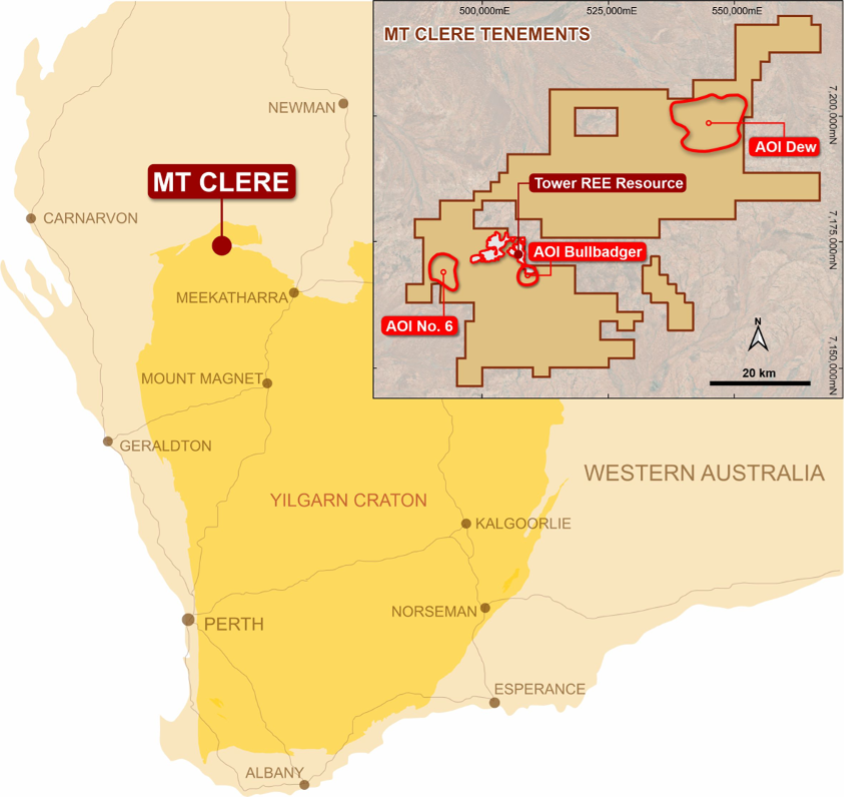
Figure 1 – Location of Krakatoa Mt Clere exploration licences within the Yilgarn Craton. Insert is highlighting known REE anomalies and the Tower REE Resource within the tenure; one of many opportunities at Mt Clere.
The region has been multiply deformed and metamorphosed at medium to high grade, and intruded by granite and pegmatite, and then later deformed and metamorphosed at medium to high grade. Parts of the region (the Yarlarweelor Gneiss Complex) were yet further deformed and metamorphosed at low to medium grade during the Capricorn Orogeny at 1830–1780 Ma, intruded by voluminous granite sheets and dykes.
Carbonatite dykes and lamprophyre dykes, which have been identified in diamond exploration, are probably common and could have been emplaced at this time.
The Yilgarn represents the deepest and most severely weathered region in Australia. Large tracts are covered by a considerable thickness of regolith, being dominated by sand plains, laterite and transported sedimentary cover.
The tenement is covered extensively by laterite, which is being eroded into unconsolidated sand, silt and gravel in braided steams and broad alluvial sheet-wash and colluvial plains. The presence of this regolith can commonly be a major impediment to exploration, but here monazite is concentrated in the alluvial areas and REE probably is enriched in the lateritic regolith, so regolith is the primary exploration target.
The Errabiddy Shear Zone, a 5km to 20km wide major crustal suture that binds the accreted Palaeoproterozoic Glenburgh terrane to the Archaean Yilgarn Craton is partly captured within Krakatoa’s applications. Such reworked craton margins are a favourable setting for many large-scale gold and base metal deposits, where long-lived crustal-scale structures can act as conduits for the transfer of heat and mineralising fluids from the upper mantle. The structural corridor associated with the Errabiddy Shear Zone offers the Company further significant gold exploration opportunities.
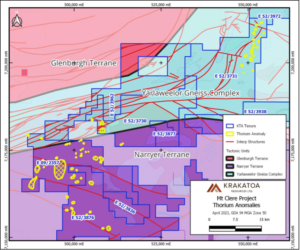
Figure 2 Elevated Thorium Anomalies over GSWA Tectonic units and major structural corridors.
The discovery of the Tower deposit was made in April 2022. Within 7 months the discovery was transformed into a world class clay hosted REE resource (JORC 2012).
The impressive maiden Mineral Resource estimate of 101MT @ 840ppm TREO (Total Rare Earth Oxide)(1), is highlighted by thick zones of near-surface mineralisation. 40% of the Mineral Resource estimate has been classified in an Indicated category. Significantly, the existing resource has the potential to substantially grow in size and scale as the Mineral Resource estimate only incorporates 20% of the identified Exploration Target drilled to date.
An Exploration Target(2) for the Tower area of 57 – 481MT at 530-1050ppm TREO.
Krakatoa has completed another milestone achieving excellent metallurgical recoveries on the critical key rare earth elements Neodymium (Nd) and Praseodymium (Pr) of up to 64% and 61% respectively using simple extraction techniques. These initial recovery rates compare favourably with other globally significant clay hosted REE projects.
The metallurgical and mineralogy test work has been completed by the Australian Nuclear Science and Technology Organisation (ANSTO) and importantly, the results from the program will be used by Krakatoa to optimise the extraction process options and develop a viable processing and production pathway at Tower.
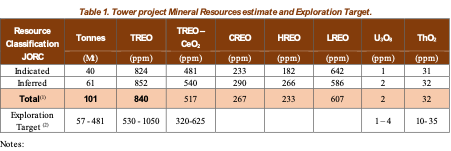
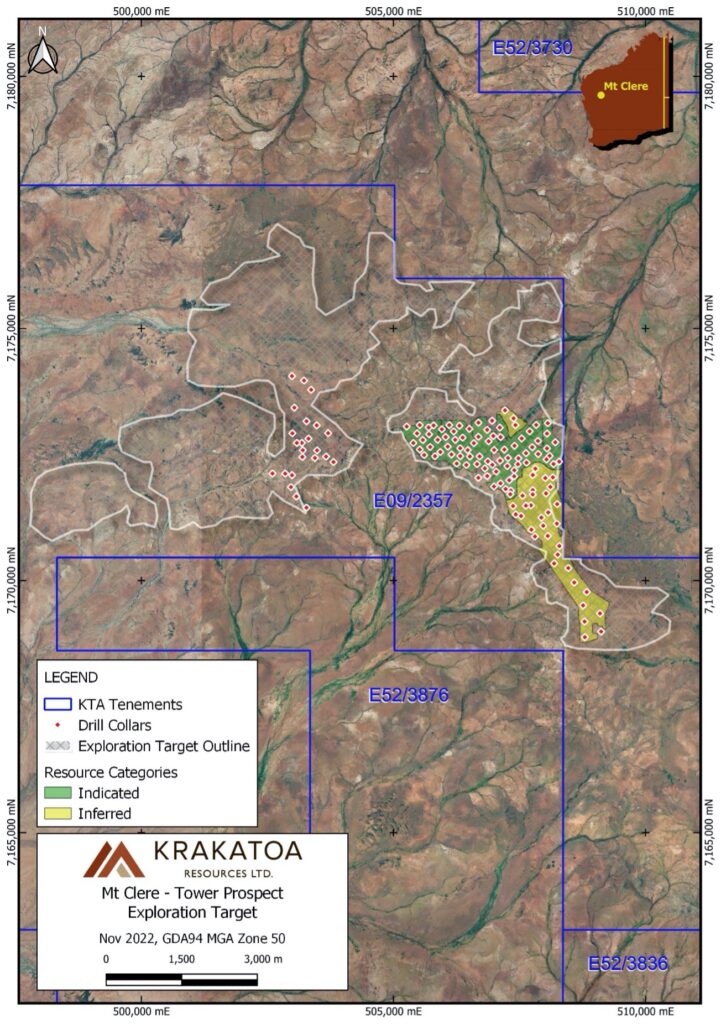
Figure 3 Map showing the extent of the Tower clay hosted REE Mineral Resource and the potential expansive Exploration Target extensions.
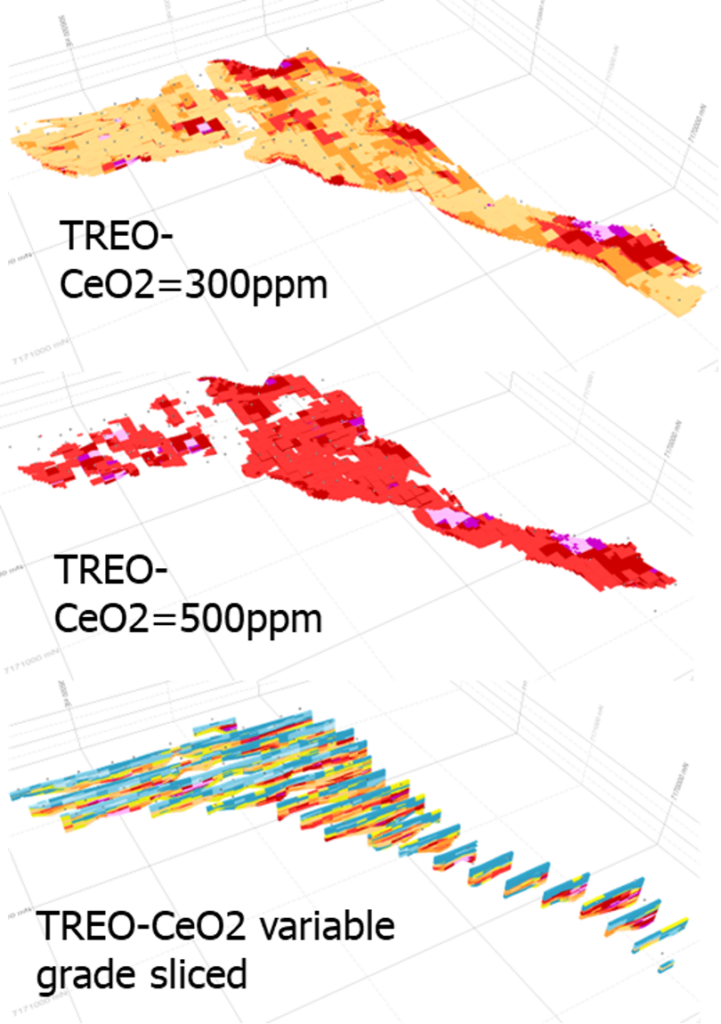
Figure 4 Block modelling total rare earth oxide grade distribution of the Mineral Resource Estimate at the Tower Deposit
The source of the monazite is postulated as coming from the alkaline gneiss and other preserved, deeply weathered, lateritic profiles developed in gneissic rocks. Monazite-rich carbonatites in the adjacent Mt Gould Alkaline Province could also provide a source and exist in the area.
The Mt Clere area include several extraordinarily, high tenor thorium radiometric anomalies which cover vast areas. Some anomalies correspond with alluvial/colluvial/sheetwash areas, where Astro pan concentrates returned remarkably high percentages of monazite, up to 48%. Several thorium anomalies appear to be caused by substantial placer concentrations of monazite. Others correspond with the incised remnants of laterite widely preserved in the project area and several very discreet clusters.
These deeply weathered terrain developed in the country rocks (laterite) may represent the primary sources for the monazite found within the drainage networks. Clay hosted REE type deposits have been identified and with one already established as a resource. These deposits are similar to those found in South China. The supergene, ion-adsorption REE clay deposits are formed as a result of in-situ lateritic weathering of REE-rich host rocks, leading to the formation of aluminosilicate clays that are capable of adsorbing dissolved REE. Coincident areas between deeply weathered bedrock and high tenor radiometric thorium form a prime target for this style of REE deposits.
The ultimate bedrock source of the thorium and REE remains unknown. Swarms of alkaline ultramafic dykes (lamprophyres/carbonatites), mostly obscured by laterite, are a potential source. Alternatively, a pegmatite-rich granite gneiss such as that identified at Mt Clere may be the source. Each forms an exploration target, in addition to the more widespread placer and lateritic concentrations.
The GSWA stream sediments capture distinct carbonatite signatures (Nb-Ce-Y-Th anomalies) in drainages adjacent to where Astro identified three lamprophyres. The signatures may be genetically related to a hidden carbonatite, obscured by the extensive laterite cover in the anomaly hinterland.
Other valuable heavy minerals such as zircon (to 60%), ilmenite (to 29%) and leucoxene were recovered in samples from the same area, favourable for large placer resources of easily recoverable material.
Chalice Gold Mines (ASX: CHN) recent Ni-Cu-PGE Julimar discovery, located near Perth in the similarly aged Southwest terrane, has renewed exploration interest in the Narryer terrane. Like the former, the Narryer terrane, consists of relatively high-grade granitic gneisses interlayered with metasedimentary rocks that are intruded by granite and pegmatite. Thus, the Narryer terrane is prospective for similar mineralisation-styles including Ni-Cu-PGE (e.g. Julimar) and orogenic style veining (e.g. Boddington).
From 1995, exploration programs were completed by BHP, Astro Mining NL, and All Star Resources Plc. A summary of this work is detailed below.
Between 1985-1987, a comprehensive programme of stream sediment sampling, heavy mineral sampling and mineralogical analysis across the eastern portion of the Mt Clere Rare Earth Project, targeting Pb-Zn-Ag mineralisation similar to that found at Broken Hill.
Heavy mineral sampling was completed at the approximate density of 500 samples per 1,000km2. The sampling confirmed the presence of gahnite (a mineral associated with Pb-Zn-Ag mineralisation at Broken Hill) but failed to locate any base metal mineralisation.
The ample presence of monazite in pan concentrates, with grades exceeding 50%, was confirmed in greater than 20% of the 176 samples. BHP classified the samples as follows (WAMEX Report A30270):
A = Abundant = >50% of estimated relative abundance of grains
C = Common = 30 – 50%
F = Frequent = 5 – 30%
R = Rare = <5%
The resulting abundances for monazite (n=176 samples) is: Abundant = 21.4% Common = 26%; thus 47.4% of the samples returned a relative abundance exceeding 30% monazite.
The anomalous samples have not been investigated further, nor has the REE distribution within the monazite been assessed. Given The samples also report varying levels of ilmenite and zircon.
Petrographic analysis of 20 samples sites across the Project area confirmed the following accessory occurrences, which are indicative of REE prospectivity:
Between 2005 and 2006, Astro Mining explored the western portion of the Mt Clere Rare Earth Project for diamonds. Nineteen discrete, primitive, alkaline lamprophyres were located during their search, which involved stream sediment sampling and geological surveys.
Though no micro-diamonds were recovered by Astro, grain counts of mineral species in selected samples of heavy mineral concentrates produced extraordinarily high monazite (up to 48%) and very high zircon (up to 60%), ilmenite (up to 29%) and leucoxene (up to 20%). The results independently validate the thorium and REE prospectivity latent in the Project (WAMEX report A58632).
Diamond exploration was unsuccessful for Astro. However, their work has proved very fertile for rare earth elements, niobium and thorium mineralisation. The company recognised lamprophyre rocks of a deep crustal origin within a highly complex area located at the edge of an Archaean craton. This supports the area as having the considerable potential for a suit of intrusive alkaline ultramafic rocks, including carbonatites which are known hosts for REE.
All Star collected two large samples of alluvium in 2006 to produce a heavy mineral concentrate. Each concentrate was sent for analysis and microscopic mineral examination at Genalysis Laboratory Services. The two samples respectively returned 3% and 2% monazite, as well as 1.4% zircon, 40% and 44% ilmenite, and 9.9% titanium. Rare earth elements, cerium and lanthanum, reported at 0.46% and to 0.25%, respectively.
Seventy-seven samples were collected at a maximum depth of 1.8 metres from auger drilling in 2007. Of the 77 auger regolith samples taken, 55 returned an encouraging grade of over 50 ppm cerium, 30 returned a grade of over 50 ppm lanthanum, and 17 returned a grade of over 200 ppm zircon. Thirty-three (33) samples graded over 30 ppm neodymium, with highs of 360 ppm, 103 ppm, 102 ppm, 95.9 ppm, 87.6 ppm, and 82.6 ppm. Whereas, sample EBA052 [506041 Z50E, 7184977 Z50N] recorded 320 ppm thorium, 660 ppm lanthanum, 37 ppm yttrium, 360 ppm neodymium, 112 ppm praseodymium, 43 ppm samarium. The results confirm the presence of monazite and other rare earths in the alluvium.
Previous explorers noted the three REE target styles are: